Welcome to the forums at seaphages.org. Please feel free to ask any questions related to the SEA-PHAGES program. Any logged-in user may post new topics and reply to existing topics. If you'd like to see a new forum created, please contact us using our form or email us at info@seaphages.org.
Recent Activity
All posts created by debbie
| Link to this post | posted 22 Oct, 2025 15:00 | |
|---|---|
|
|
Nope! But provide that here and I will add that to the function list, so others can pick the best model number. Would that work? Also provide me with the list of genes that you have called. I can add them as examples too. Thanks, debbie |
| Link to this post | posted 22 Oct, 2025 14:51 | |
|---|---|
|
|
Hi Peter, We are going to cautiously weigh in on what to name the various structures of siphoviruses. The data is coming to us fast and furious, and not all crystallographers are using the same nomenclature. I have added the features (as you have identified)to the Approved Function List that I think we can call with a modicum of confidence. Let me know if my list works! Thanks, debbie |
| Link to this post | posted 21 Oct, 2025 19:31 | |
|---|---|
|
|
Hi Brian, The difference in the gene count is that PECAAN is not counting tRNAs. I don't believe that there is a gene duplication per se. regardless, that is why the curation work that you and your students do is so important! Happy annotating! Best, debbie |
Posted in: Phamerator → Phamerator/PECAAN map diferences
| Link to this post | posted 02 Oct, 2025 01:05 | |
|---|---|
|
|
HI Brian, When I look at the Starterator report, I see one common start for every phage listed - it is technically threaded through the starts listed as 9, 10 and 11. Which is the start that corresponds to bp 110. Remember that starterator is a clustal alignment and as the sequence diverges, small discrepancies at the nucleotide level can be present. I would call 110 as the start. debbie |
Posted in: Annotation → Calling start in FC phage Phrampa
| Link to this post | posted 24 Sep, 2025 18:59 | |
|---|---|
|
|
Hi Allie, Yes, i think that Feature 89 (50477-50701bp) and Feature 91 (50689-50862bp) have more evidence to support keeping them than Feature 90R (50695-50546bp). I would delete Feature 90R (50695-50546bp). Best, debbie |
| Link to this post | posted 22 Sep, 2025 17:13 | |
|---|---|
|
|
Hi Allie, I would keep it. I particularly like the coding potential (those slight) when using M. tb as the model. I am also not as concerned about the overlap, because it is the c-terminus of both genes that overlap, meaning that as they get transcribed/translated, the process started upstream and went through to completion. there is no upstream sequence needed to get their translation/transcription started. Note too, that the sequence is well-conserved across other clusters, even though these are tiny little genes. What do you think? debbie |
| Link to this post | posted 18 Sep, 2025 15:29 | |
|---|---|
|
|
Hi Beth, That is a good question. I recommend that you only post single purified phages on phagesDB and archive those with us. What do do with 'other' samples that are not purified is really up to you. To save stuff for a future date, it then becomes a storage and record keeping issue. If you are asking how to store them, that depends on volume. Storing phages in high enough volumes in the frig will work for a while (likely years), and very host dependent. You can add 7% DMSO to the samples and store at 4C. Hope that helps! debbie |
| Link to this post | posted 03 Sep, 2025 23:36 | |
|---|---|
|
|
fixed! |
Posted in: Bioinformatic Tools and Analyses → Genome length listed as unknown for phage PestoPenguin on PhagesDB
| Link to this post | posted 02 Sep, 2025 13:23 | |
|---|---|
|
|
Kissaou, The power of comparative genomics will aid in this quest to see if it is plausible that a gene is present in this area. If there an open reading frame that looks plausible. you can blast n and blast p the area. if this area is highly conserved, what are the possible explanations? If it is not conserved, what does that tell you. Check out the dates of the genomes that have this sequence. What have they called. What is the evidence on which they made their calls. That data is all present in the tools that you have access to. Lots of information, tricky decision. let us know what you find out. debbie |
Posted in: Functional Annotation → a gene in this gap?
| Link to this post | posted 02 Sep, 2025 13:18 | |
|---|---|
|
|
Kissaou from Austin Community college wrote: I am kissaou , and I am making this post regarind Mycobacterium phage "Teodoridan" Cluster A1 we completed the annotation, but I am a little it not happy about the 311 bp between gene 2 and gene 3. Any idea? Looking at DNA master frames, it is possible to inser a gene between Start 1474bp - stop 1665bp. However, looking at glimmer and genemarks, there is not a reall coding potential. What everybody else think? Thanks Kissaou |
Posted in: Functional Annotation → a gene in this gap?

